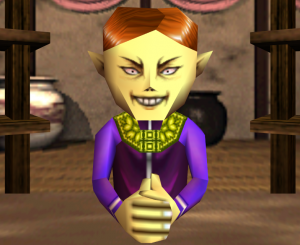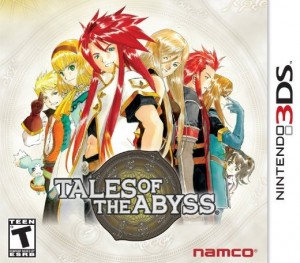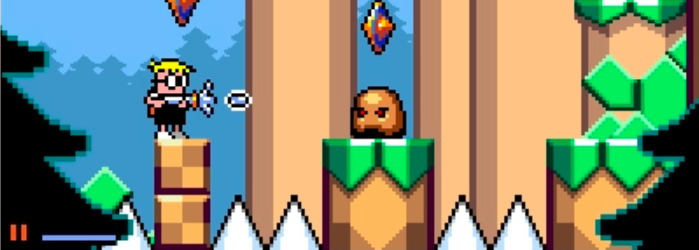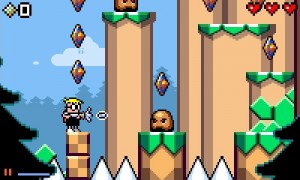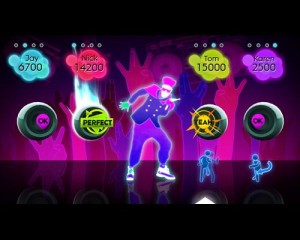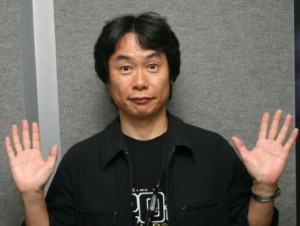Gaming Journalists’ Views On Games Are Stupid and Don’t Mean Anything
Posted on 13 years ago by Austin(@NE_Austin) in Features, General Nintendo | 0 comments
Part 2!
I’ve tried starting this article a bunch of times now and I can’t quite strike the right tone so I’m just going to reveal the punch line right away instead of doing some drawn out build up because I’m supposed to: Game reviews are stupid, and gaming-related articles are stupid. The whole façade that we (us gaming writers) know what we’re talking about is stupid, and it’s just that; a façade. Every single person who sits in front of a keyboard to write about video games has a job to do, and that’s to make their readers think they are smarter than them. I’m here to let you know that they’re not smarter than you. I’m not smarter than you. Hell, I’m probably way dumber than you, and that is okay. I just want to make you feel like your opinion is worth more than any game journalist’s.
Your Views on Games Are Stupid and Don’t Mean Anything
Posted on 13 years ago by Austin(@NE_Austin) in Features, General Nintendo | 0 comments
Continuing my series of “article titles that make people click on them”, I’ve got a point to make today that I think is really important. You see, like the best of us, I always get into arguments about video games with friends or with Internet demons. Usually it’s Nintendo-related, and at the end of the day the bottom line always remains the same; “I think what I think and you think what you think and who cares.” We can argue day and night about why Skyward Sword isn’t the worst game in the series, or why Mario doesn’t need a story to be important, but the overall conclusion to the argument never ever changes. It’s always a “live and let live” sort of ideology.
Which is great, right? The fact that we have such respect for each other’s beliefs and we are understanding enough human beings to realize the triviality of arguing about video games is wonderful! Except that we don’t. I don’t think I’ve ever seen one person who- when faced with the opportunity of gaming related debate- simply stated outright that opinions on these things aren’t important, and everyone should just enjoy what they enjoy.
A Brief History of Zelda and Why It Sucks
Posted on 13 years ago by Austin(@NE_Austin) in Features, General Nintendo | 10 Comments
There’s something to be said for article titles that trick people into clicking the link in order to get hits, but whatever that something is, I’m not going to say it in this article because this article is about Zelda and not about the evil and devilish ways the blogging industry makes itself successful. Ah yea, Zelda. A series that last year held its 25th anniversary bash, and as the celebrations continue into 2012 with the touring Zelda symphony, a lot of people are taking advantage of this popularity to write articles that make people upset. The latest in this string of upsetting editorials comes from Kotaku’s Tevis Thompson, who yesterday put out a gem titled “Zelda Just Keeps Getting Worse, But It’s Not Beyond Saving.”
Now, I was linked this article by a friend of mine (who happens to share most of Mr. Thompson’s views on the series), and very very quickly knew I wasn’t particularly interested in finishing a read-through. Somewhere between saying “The original Legend of Zelda is the greatest Zelda” and “Zelda would be better if it had no story”, it was simply clear that this particular article was not meant for my eyes. I mean not to dissuade you from reading it- by all means, here is the link– but frankly… the arguments made within were both incredibly merited and deeply flawed, jumping back and forth quickly enough to give one whiplash. However, that doesn’t mean I didn’t take something from reading it. I took an obnoxious reminder as to what I imagine is the main difficulty with developing Zelda games must be from reading it: the fans.
Tales of the Abyss review
Posted on 13 years ago by Patrick(@Patricklous) in 3DS, Reviews | 3 Comments
Game info:
System: Nintendo 3DS
Genre: RPG
Players: 1
Release Date: November 25, 2011 (EU)/February 14, 2012 (US)
Developer: Namco Bandai
Publisher: Namco Bandai
After the Nintendo DS became a virtual Mecca of fantastic RPGs, it’s strange that the console’s older brother has been around for almost a whole year with barely any games to scratch that role-playing itch. Aside from Atlus’ Devil Survivor: Overclocked, there haven’t been any other RPGs on the 3DS, so thankfully Namco Bandai are finally trying to fill the niche with this recently-released port of Tales of the Abyss. Originally released on the Playstation 2 back in 2006, Tales of the Abyss —part of Namco’s long-running Tales series— told an anime-styled story about “the meaning of birth” and was met with fairly positive reviews. But the PS2 is a completely different system to Nintendo’s handheld console, so does this RPG make the transition to a portable system completely intact?
Review: Mutant Mudds
Posted on 13 years ago by Austin(@NE_Austin) in 3DS, Features, Reviews | 0 comments
Game: Mutant Mudds
System: 3DS (eShop)
Cost: $8.99
Release Date: January 26, 2012
Developer: Renegade Kid
I haven’t done a game review in a long time. There are a lot of reasons for that, but mostly it boils down to the fact that I normally don’t enjoy trying to sift through everything I feel about a game, stamp a number on it, and then tell you to buy something you may or may not like. Nothing really makes my opinion better than any of your guys’, and it’s taken a while for me to fully realize that. Still, I’m giving reviews another shot anyway, and hopefully I won’t look back on this one with as much regret as I do my Call of Duty: World at War and The Conduit reviews. Those games are not as good I claimed, but I’m pretty sure this next one is.
What game do I have the pleasure of reviewing today? The astonishingly charming platformer, Mutant Mudds.
Talking with Jools Watsham: Mutant Mudds, Dementium 3D, DLC, more…
Posted on 13 years ago by Austin(@NE_Austin) in 3DS, Features, Interviews | 0 comments
It was nearly eight months ago now I first got to sit down- on a bench outside of the Electronic Entertainment Expo (E3), no less- and play Renegade Kid’s upcoming 2D/3D platformer, Maximillion and the Rise of the Mutant Mudds. There wasn’t a fancy playing station, there weren’t any giant LED screens, and not a single booth babe could be seen; in layman’s terms, all of the flash and glamour of E3 was left indoors with the big budget games, alongside the bells and whistles we’ve come to expect from them. When I played Mudds, the only thing that could force me into enjoyment was the game itself, and much to my delight, it was every bit as fun as I had hoped.
Which is really quite good because believe me, there really isn’t anything more awkward and difficult than telling a developer to his or her face that you don’t like their game.
Fast forward to now, and the game is finally nearing its release date (January 26th, for those unaware!), garnering some much-needed media attention to drum up the hype required for it to sell. Being the good gaming “journalist” I am, I figured it was time for me to do my part, so I sat down with Renegade Kid CEO and co-founder Jools Watsham and forced him to answer some questions in return for my services of marketing his game. Because we at NintendoEverything are nothing but a bunch of sellouts who make absolutely no money. Hit the break for the interview…
In Defense of Party Games; Game Reviewers Are Full Of Sh*t
Posted on 14 years ago by Austin(@NE_Austin) in Features, General Nintendo | 0 comments
Today was Christmas, and seeing as how I’m a human-being who celebrates and enjoys all of the consumerism and materialistic goodness associated with the day, it was only natural that I would spend some time with my family and friends. I hadn’t planned on playing Just Dance. Heck, I was exhausted from how long the day was, but when I was urged to rekindle my relationship with the game, I just couldn’t resist. I stood up- Wiimote in hand- and danced my ass off to “Viva Las Vegas” and “Girlfriend”. Like every single time I’ve played that game, I came away completely baffled at how anyone could dislike it.
That One Show – A Look “Back” On Skyward Sword
Posted on 14 years ago by Austin(@NE_Austin) in Features, Wii | 0 comments
I’m always so torn on whether or not to make these longer or shorter… I used to have them this long, then people complained to I made em shorter, and then more people complained so I’ve gone back to having them longer. Help me make up my mind!
Post of the Day: Motion Controls + Zelda = Forever
Posted on 14 years ago by Austin(@NE_Austin) in Features, General Nintendo | 0 comments
Read today’s PotD here.
Okay, maybe I overexagerrated with the “forever” thing, but I think it’s safe to say that- at least for a next few console entries of the series- we’ll be ‘stuck’ using motion controls to control our favorite hero. The question is: Is this a good thing, or a bad thing? That’s where you guys come in. For those of you that have played Skyward Sword, why do you like/dislike the controls? Do you think they should stay with the series for a while? Let us discuss! (I shall start; see my comment in the comments section)
Post of the Day: What if Miyamoto “retired”? What would YOU want to happen?
Posted on 14 years ago by Austin(@NE_Austin) in Features, General Nintendo | 0 comments
You can read today’s post of the day here.
Okay, so by now we’ve all heard the news that Miyamoto is not retiring, changing roles, or pretty much anything that the Wired interview said he was doing. I don’t know what got lost in translation there, but frankly it doesn’t really matter at this point! He’s here to stay… at least for a few years. But, I have a question for all of you: Let’s say Miyamoto did retire/step down/whatever. What would you look for in that situation? Let me go over a few possibilities…
In the case that he steps down, maybe he’d stop work on games like Mario and Zelda in lieu of Pikmin, and other smaller Nintendo franchises. If he did this, I’d really like to see him finish Pikmin 3 firstly, and then go in and really work hard on a new Star Fox game. I mean, seriously, when are we finally going to see another great entry into that fantastic (err… sort of fantastic) franchise? I grew up with it, and by golly, I want to keep growing up with it!
But let’s say he stops working on established franchises altogether, and instead goes for making new IPs with a smaller team. I don’t know about you guys, but what I’d want to see is him delving into some really deep and trippy emotional stuff, like he dabbled in with The Legend of Zelda: Majora’s Mask. That game was so dense and layered and fantastic that I got lost in it within half a second, but it took me years- quite literally- to realize the full depth to which that game went in dealing with the emotional and psychological properties of mortality. It was a great game in its own right, but realizing those subtleties makes Miyamoto’s projects that much better.
Lastly, what if he left Nintendo altogether and just stopped making games? This one is the hardest to predict, but I’d really like to hear your guys’ thoughts on this! You can probably come up with more interesting scenarios than I can anyway…
